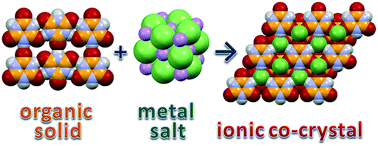当前位置:
X-MOL 学术
›
CrystEngComm
›
论文详情
Our official English website, www.x-mol.net, welcomes your
feedback! (Note: you will need to create a separate account there.)
Organic–inorganic ionic co-crystals: a new class of multipurpose compounds
CrystEngComm ( IF 2.6 ) Pub Date : 2018-03-23 00:00:00 , DOI: 10.1039/c8ce00304a Dario Braga 1, 2, 3, 4 , Fabrizia Grepioni 1, 2, 3, 4 , Oleksii Shemchuk 1, 2, 3, 4
CrystEngComm ( IF 2.6 ) Pub Date : 2018-03-23 00:00:00 , DOI: 10.1039/c8ce00304a Dario Braga 1, 2, 3, 4 , Fabrizia Grepioni 1, 2, 3, 4 , Oleksii Shemchuk 1, 2, 3, 4
Affiliation

|
In this highlight, the reasons for the widespread interest generated by ionic co-crystals, namely those formed by a neutral molecule and a salt, are addressed. In particular, the class of compounds obtained by co-crystallization of neutral organic molecules and inorganic salts (e.g. alkali and alkaline earth halides, sulfates, phosphates etc.) is discussed with the focus on their applications in diverse areas, such as pharmaceuticals, food and fertilizers, and also in chiral resolution. It is argued that, in terms of structure and intermolecular bonding features, these compounds do not differ from classical coordination compounds (complexes) and that their popularity arises from the effectiveness of the organic–inorganic assembly to enhance thermal stability, improve particle size and morphology and change significantly the solubility and dissolution rate with respect to those of the pure active ingredients.
中文翻译:

有机-无机离子共晶体:一类新型的多用途化合物
在这一亮点中,解决了引起离子共晶体产生广泛关注的原因,即由中性分子和盐形成的共晶体的原因。特别是通过中性有机分子和无机盐(例如碱金属和碱土金属的卤化物,硫酸盐,磷酸盐等)的共结晶获得的一类化合物。)将重点讨论它们在制药,食品和化肥等不同领域中的应用,以及手性拆分中的应用。有人认为,就结构和分子间键合特征而言,这些化合物与经典的配位化合物(配合物)没有区别,它们的流行是由于有机-无机组装增强热稳定性,改善粒径和形态的有效性。相对于纯活性成分而言,其溶解度和溶解速率发生了显着变化。
更新日期:2018-03-23
中文翻译:

有机-无机离子共晶体:一类新型的多用途化合物
在这一亮点中,解决了引起离子共晶体产生广泛关注的原因,即由中性分子和盐形成的共晶体的原因。特别是通过中性有机分子和无机盐(例如碱金属和碱土金属的卤化物,硫酸盐,磷酸盐等)的共结晶获得的一类化合物。)将重点讨论它们在制药,食品和化肥等不同领域中的应用,以及手性拆分中的应用。有人认为,就结构和分子间键合特征而言,这些化合物与经典的配位化合物(配合物)没有区别,它们的流行是由于有机-无机组装增强热稳定性,改善粒径和形态的有效性。相对于纯活性成分而言,其溶解度和溶解速率发生了显着变化。











































 京公网安备 11010802027423号
京公网安备 11010802027423号